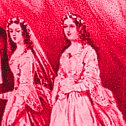History and etiquette tell us that Mister and Missus, known by the contractions Mr. and Mrs., are the proper form of address for men and women. Beneath the surface of these everyday honorifics lies a linguistic glitch that has spawned social havoc since “Mrs.” entered mainstream English in the 17th century.
Mister is a direct variant of master, which in turn derives from the Old English maegester meaning “one having control or authority.” Already a discrepancy rears its head: The period that follows the abbreviation Mr. is usually omitted in British English grammar. According to the Oxford A-Z of Grammar and Punctuation, “If the abbreviation includes both the first and last letter of the abbreviated word, as in ‘mister’ and ‘doctor’, a full stop is not used.” However, a period always follows the title in American English grammar – as in Mr. President and Mr. Speaker.
Once used to address men under the rank of knighthood, by the mid-18th century mister became a common English honorific to generally address males of a higher social rank. English domestic servants often used the title to distinguish the eldest member of the household – a practice that is, for the most part, obsolete today.
Mrs. is a contraction derived from Middle English maistresse, “female teacher, governess.” Once a title of courtesy, mistress fell into disuse around the late 14th century. The pronunciation, however, remained intact. By the 15th century, mistress evolved into a derogatory term for “a kept woman of a married man.”
By the early 17th century, Mr., Mrs. Ms. and Miss became part of English vernacular, creating an awkward socio-linguistic discrepancy. In an attempt to avoid the use of “mistress,” a variety of phonetic substitutes have been utilized, including “missus” or “missis.”
While Mrs. does refer to a married woman, according to The Emily Post Institute, Ms. is the proper way to address a woman regardless of marital status — the term alleviates any guesswork. Miss is often used to address an unmarried woman, presumably a girl under the age of eighteen years old. Note however, that “Miss” also derives from “mistress.”
In 2011, what is the proper manner of address for men and women? Miss, Ms., or something entirely different? Are these honorifics too formal for our society, or the perfect bit of courtesy?
2 comments:
I think there is one word which rules American society today: casual, Casual, CASUAL! Now, I was always taught to address adults using "Mr." or "Mrs." and their last name. The only time I would use their first name is if they specifically requested it. Today, there are some people who like to adhere to tradition and others who DO NOT. For example, I remember a situation where a lady became noticeably irritated when I referred to her as "Ma'am." (Usually, I'm in the habit of saying, "Yes, sir," or "No, ma'am" when someone older is assisting me.) She claimed that "ma'am" made her sound really old. I can understand her feelings. I don't necessarily like being called "Miss," because I think it makes me sound younger than I am. (Ironic, isn't it?) But, to be honest, I would rather receive a cordial "Miss" than a "Hey, you!"
It seems to be a matter of opinion, though. Girls? Any thoughts? Guys? Do you prefer being called "Sir?"
Great thoughts and cultural observations:) I think it may depend on the setting of the conversation, regarding whether or not to use proper titles. Sometimes we may come up with hybrid titles. For example, at project upward bound, I am "Miss Rebecca" . For me, this is a good title because its got that hint of respect/status "Miss" but also that causal, allowing the students to see me, to a certain degree as casual and perhaps more approachable "Rebecca". So yeah, great thoughts.
Post a Comment